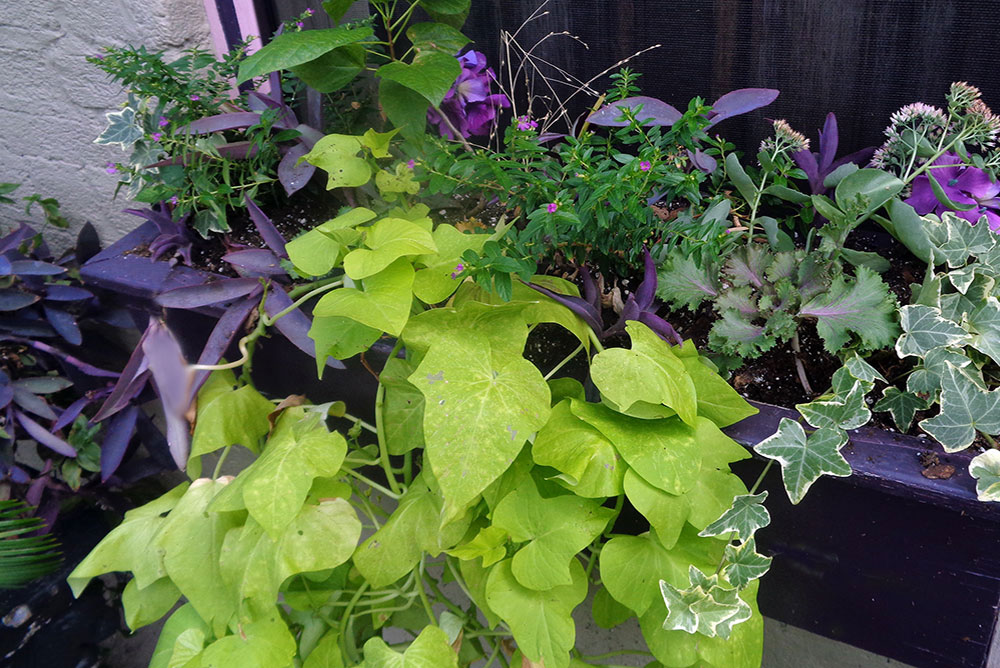
That’s a teeny tiny kale plant tucked in between the ivy on the right and the sweet-potato vine at center. By mid-winter that little sprig will be full-size. / Photo by Stephanie Cavanaugh.
By Stephanie Cavanaugh
IT’S TIME once again time for the sniffinpoofs* to flair their aristocratic nostrils at the very thought of planting flowering cabbages and kale. So pedestrian! So boring! So overdone!
So what.
Dissing these plants has been going on for years, 30 or so by my count. Yet, they continue to be planted—and thank the gods of gardening for that.
Few plants ride out the winter in such glorious color. Hot pinks and greens and purples and combinations of such, in the ruffled leaves of kale and smooth leaves of cabbages (both are part of the kale family, the leaves are the difference).
The size of basketballs at maturity, they are as delightful to the eye as a child’s birthday card, one of the ones with bunnies sniffing roses and butterflies winging about and blue birds in the branches of the flowering trees all thoroughly doused with glitter. Do they still make cards like that?
Anyway. Perhaps they’re overdone in the suburbs; being a city person, I wouldn’t know. In the small gardens around here in Capitol Hill, they’re a delight. While pansies, that other winter stalwart, weather the weather just fine, they still flinch at the cold, sitting in a huddled clump waiting for the sun. Cabbages and kale brave whatever winter tosses at them, petals spread wide as if to say Bring it on, do your bloody worst.
Both varieties are particularly charming, and useful, in window boxes. Mix them with pansies and ivy for a cheerful, cold-tolerant display from now until spring: A depressing window box (0r five) full of dirt is not a necessary by-product of winter.
In the garden, as well as in boxes and planters, they can be planted over tulips and flowering bulbs: The bulbs will push their way up, wriggling round whatever is planted above, and flower to fine effect.
Wherever you plant them, remember to water. Some people, me for instance, get lackadaisical about watering in the middle of winter, an unhealthy habit.
BIG TIP: Start them small, otherwise they’ll bolt before spring, sending up Dr. Seussian frizzles above limp leaves. This is not attractive.
Keep your eye out for six-packs of wee ones, particularly if you’re planting window boxes or pots. Big-box hardware chains are probably your best bet; most garden centers, I’ve found, stock only the full-leafed, glamorous big kahunas.
Small ones can be squished into spaces where summer plants are breathing their last glorious breaths and will ripen soon enough to replace spent blossoms and foliage, reaching full size when you need color and joy most. In the dead cold of winter.
*Not a word, but should be.
MyLittleBird often includes links to products we write about. Our editorial choices are made independently; nonetheless, a purchase made through such a link can sometimes result in MyLittleBird receiving a commission on the sale, whether through a retailer, an online store or Amazon.com.
